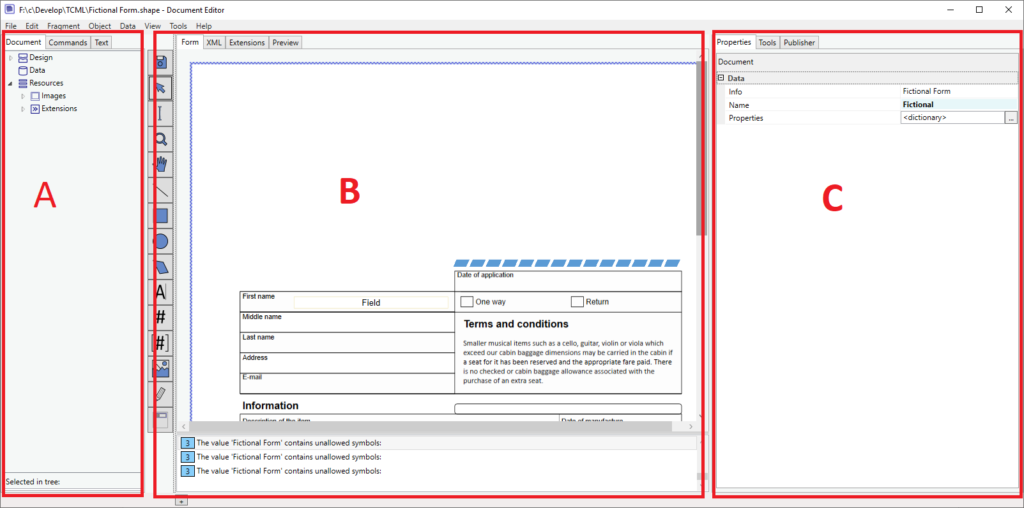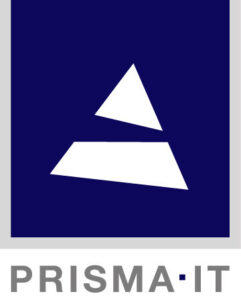Generic document
The software aims to implement a portable, efficient, and extendable document processing framework with a reasonable set of design and runtime tools. A single document template can be processed on multiple platforms, exported into various output formats, and archived. Import and export modules can be easily added via APIs or by using the straightforward and open XML-based document format5. JavaScript can be used to implement custom functionality.
The Editor works with two major aspects of a document – layout and data model. The layout is constructed from nested fragments, which are logical sub-units of the document. In a simple static usage scenario, a fragment equates to a page. There are fixed dimensions, and the content holds text labels, lines, curves, images, barcodes, and similar elements. A dynamic document may be built using an arbitrary level of nested elements. For example, in a typical invoice, there are headers, footers, and dynamic containers for invoice rows9. The invoice row fragment is bound to the invoice_rows collection in the data model at design time, and the container fragment will be populated with repeated instances of rows at runtime. Each container of fragments has its own layout method (for instance, vertical stacking, horizontal wrapping, fixed position, etc.)
Document Format
The file format is based on XML, which facilitates processing even by third-party tools. Textual content in the document uses UTF-8 encoded Unicode. Custom data can be stored along with different parts of the DOM (document object model) as dictionaries. The dictionary is a nested collection of key-value pairs, essentially a mini-database for arbitrary data. When any custom solution needs to store data along with the document, it can be added without necessitating changes in the file format.
Most elements in the DOM have the name attribute. The value of the name is not free text; there are syntax restrictions necessary to allow element access from JavaScript. The name must also be usable as an entity in the document’s internal path specification. The user interface reports (but does not directly prevent) the use of spaces and other unsupported characters in the name. The info property that appears along with the name can be used as a free text description of the element. Both name and info are optional values. More details can be found on the document format page.
Scripting
The behavior of the document can be enhanced by creating JavaScript extensions. The Editor includes a basic JavaScript editing tool for scripts and a wizard to create template scripts. The JS code can also be edited with any external text editor or development environment. The scripts are separate files that are linked to the document.
Please note that the preview will execute the document in merge along with the scripts, and the log messages issued by script code will appear in the application log window. The preview tool can be used for basic script testing.
Filters
Filters provide a generic way to specify an external application as a data stream modifier20. Filters may actually contain more than one processing step, so the effect is similar to chaining standard input and output streams on the Unix command line21. Filter runtime is implemented for both Linux and Windows platformsFilters.
Filters provide generic way to specify an external application as a data stream modifier. Filters may actually contain more than one processing step, so the effect is similar to chaining standard input and output streams on Unix command line. Filter runtime is implemented for Linux and Windows platform. The document preview is implemented as filter that runs merge runtime component. Filter files are typically installed next to the main application in the ./Filters/ subfolder.
Preview
The document processing runtime application is integrated with the Editor and provides actual preview from the portable production engine that can be used in Windows and Linux environments.
Preview stores a temporary copy of the document and launches optional merge application installed with Editor to produce SVG output that is then rendered in the preview area. The process is configured using filter file located in .\Filters\preview.filter in the application folder. Benefit of this setup is the fact that actual runtime is producing the preview, so it is not close emulation but rather a real deal.
The file name of example XML data can be entered in field at the top of preview panel. The preview will attempt to populate the document with data and execute the layout process.
Publisher
The publisher module integrates editor with compatible REST web service. The publisher shows list of documents installed on web service that may for instance use the documents as web forms, provide download or processing services. The purpose of the publisher is to keep track of local and installed versions, download the document for editing and re-upload with changes.
Currently we are preparing a public web services for testing this functionality.
User interface
The application main window is divided into three main areas.
A – document structure view B – main editing area C – tool and property panels.
Left side panel
Document structure area contains document DOM tree view, text model view and command history panel. DOM tree shows document element hierarchy down to the basic document objects. It does not expand internal content of text labels and resource objects. Text model view shows the structure in individual text label. Command list shows list of executed editing commands.
Main panel
Main editing area contains drawing canvas view, XML (read-only) source view, script editor and preview.
Canvas
Drawing canvas shows the document fragments in design mode, here we can draw new objects, move, resize and edit text.
XML view
XML view shows the document as it will be stored in file with optional syntax coloring. The embedded image binary objects are cropped to save space. The XML content in the current iteration is read-only.
Scripting
Script editor allows editing of associated document scripts that are stored as separate JavaScript files.
The script editor will have major changes in future versions where the scripts will be embedded and become more integral part of the main document model. For now, the changes in script content have their own Undo/Redo stack, keyboard shortcuts etc. It is essentially a separate text editing application inside the Editor. There should be also no problem to use any external application for script editing. More about scripting can be found on merge scripting reference page.
Tools
Rightmost area of the main view contains property grid and various tools.
Property Grid
The Properties panel presents various attributes of selected object. The selection can be made by clicking on the visual object in canvas view or using the DOM tree view.
Other Tools
The Position tool displays the coordinates and dimensions of visual objects. Snap point settings dictate how a specific element interacts with the grid defined in the containing fragment. The ‘Arrange’ tools facilitate changes in the z-order of content objects and align selected objects relative to each other.
The Brush tool defines the fill of a graphical object, such as a box or text container. The fill type of an object can be transparent, solid color, pattern, or gradient. When editing text, the brush panel sets the background color of the selected text range.
The Pen tool allows for changes in an object’s line properties. The pen applies to the line used to draw boxes, ellipses, polygons, and paths. It can also be used with fragment objects that have a frame definition.
The Text tool controls properties in the text and variable fields. The color of the text can be changed with the color selector located at the bottom of the toolbox. Color samples shown in the brush, pen, and text tool originate from one of the global palettes. These palettes can be customized via the Tools > Palettes menu or from the panel in the Settings dialog. Note that user-defined palettes are stored in the application data folder on the local machine and are not stored in the document.
The Grid tool allows for editing the grids on the selected fragment. Note that each fragment may have multiple grids (or none at all). The grid is defined on the fragment, so each nested fragment may have a different setup of grids. A grid is an object positioning and alignment helper, similar to the lines on plotting paper. Each object, including sub-fragments, can be connected to one of the grids (or none). This connection is defined in the snap settings for the object.
Extensions lists the document scripts. The extensions are also accessible via the Extensions tab in the main panel.


